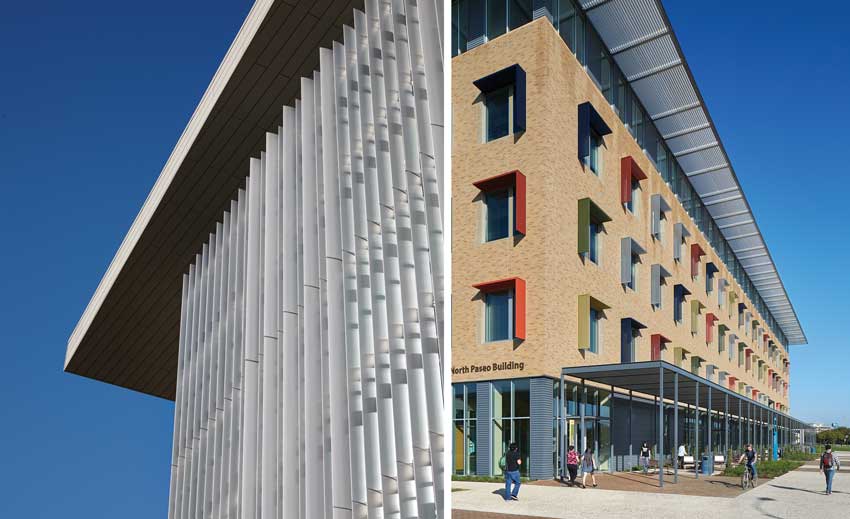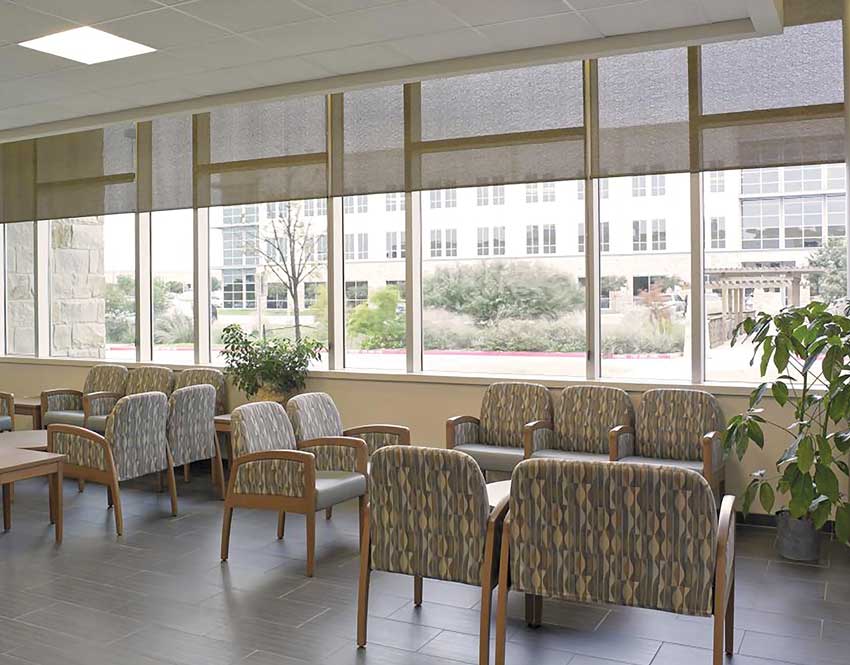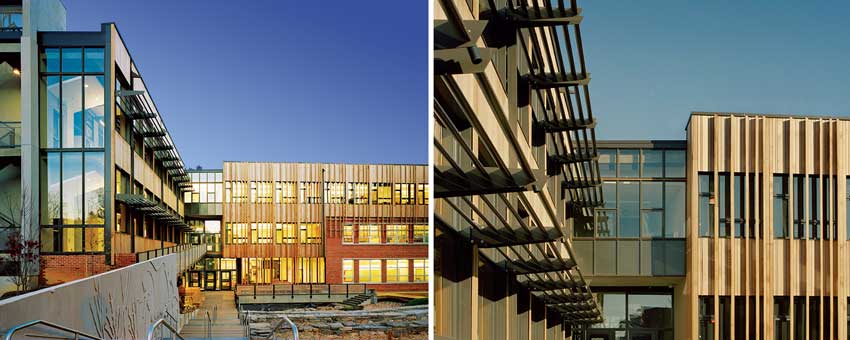Architecture for Education
Sun Controls
While allowing natural daylight into a building is proven to improve well-being and productivity in schools, excessive daylight can lead to uncomfortable glare and, depending on the compass orientation or time of day, could add more solar heat gain than desired. For these reasons, providing a solution for controlling or directing daylight into interior spaces is important for a successful outcome. Research indicates that there are different design options that can yield the sought-after results.
Exterior Sunshades
Exterior sunshades have become a common and popular design solution, as they let filtered light into a building while still allowing occupants to see out. They are particularly attractive to architects because exterior sunshades are fully customizable to suit the design of a particular project or facility. Different components are available to create a complete system, including an array of patterns, hues, textures, and lighting. “Exterior sun shade systems provide lower energy costs and reduce glare by allowing filtered light to enter a building,” says Eric Sposito, national sales manager with Construction Specialties. “They can be used to create unique architectural designs with intricate patterns, sleek textures, vivid colors, and even LED lighting. No matter how complex the architectural facade may be, an engineered sun shade solution is possible.”
Cantilevered and suspended sunshades typically project horizontally outward from the building facade, and as such are well suited for southerly facing facades. The location and angle of the horizontal bands can be adjusted to suit a project based on specific orientation, latitude location, and facade conditions. This type of sunshade is also ideally suited for installations where loads from wind and snow need to be distributed over a larger area and back to the buildings structural support system. Instead of cantilevering outward from the building, exterior sunshades can alternatively be suspended closer to the facade in either a horizontal or vertical format. This configuration is particularly well suited for east and west elevations, where low sun angles make sun control challenging.
For installations where daylight from any direction is intended to offset the use of electric lights, something is needed to help distribute the daylight evenly into interior spaces such as classrooms. Interior light shelves have been successfully employed to do just that, particularly when combined with upper or transom style windows. These light shelves intercept the upper light and redirect it deeply into the building. In this way, they reduce heat and glare, allowing students to sit adjacent to windows comfortably and productively.
When properly designed, exterior sunshades allow filtered light to enter interiors and let occupants see out. Manufacturers of exterior sunshades can also demonstrate how their products can enhance building designs while lowering its environmental impact. For some though, manufacturing the product is just the beginning. When architects are looking for an exterior sunshade solution, certain manufacturers can also provide expert guidance and engineering support in the final design and fabrication of products directly suited to individual projects. Architects can work with product engineers to design a custom system that is code compliant and structurally sound, regardless of how complex the final design may seem.
Integrating exterior sun shades into a building can be addressed through custom design options available. BBH Design Associate Tzu Chen, AIA, specified horizontal sunshades at Wake Technical Community College. He comments, “Seeing the final product, we definitely feel that the sunshades blend well with all of the [building’s] components. The abruptness of the transitions was a consideration, but it worked out nicely.”

Photos courtesy of Construction Specialties
Exterior sun shades can be incorporated in a variety of ways on a building, including horizontal or vertical installations. Properly designed and installed, they can reduce glare, improve the quality of daylighting, and still allow for views out of windows.
Interior Sun Shades
Controlling daylight and glare from the inside of a building is a design option in many cases for school buildings. Roller shades in windows have commonly been used, which allow a great deal of flexibility and control. Fully open, they can allow for full penetration of daylight and clear views to the outside for students. For times when solar control is needed to reduce glare, they can be closed fully or partly, with options available for the shade material to be either opaque or textured to intentionally obscure light transmission and visibility. In some cases, it may be desirable to provide both options in a single installation. The textured choice still allows diffused daylight to pass through, but the fabric appearance of the shade reduces the total light, thus reducing glare and producing a favorable light quality inside the building. An opaque or room darkening choice can be helpful for times when audio visual equipment is in use, which requires a lower ambient lighting condition.
Interior sun shades can help with the rejection of solar heat and have a positive impact on reducing energy needs for cooling as a result. For example, independent research using computerized energy models run for a medium-sized, two-story building in the Midwestern United States compared a baseline building with no window shades to a building design that incorporated interior sun shades. Different types of shades were modeled that ranged in the percentage of openness in the fabric (i.e., less openness equals more shade fabric per square foot). The results of the modeling and analysis showed that annual energy savings related to space cooling, heat rejection, and ventilation fans could be realized between 5 to 9 percent. These savings were attributed to the ability of the fabric to reflect solar heat and keep the building from overheating on sunny days. Hence, this data shows that it is possible to provide daylighting while still having a positive impact on overall energy use in a building.
Any product used on the interior of a school building needs to be durable in order to be practical. In the case of interior window shades, this comes in two forms. First is the shade or curtain material itself, which in this case can be specified from available, nonorganic, resilient fabrics. Second is the roller mechanism, which can be provided by manufacturers in a durable, concealed housing. The operation can be cordless to further ensure durability and create a cleaner, safer operation.

Photo courtesy of Inpro
Interior solar shades can reduce glare while still providing daylight and views. The type of fabric used can be selected for durability, aesthetics, and solar reflectance to help reduce energy costs for cooling.
Notice

www.c-sgroup.com

www.c-sgroup.com

www.guardianglass.com


www.MitsubishiPro.com

www.nanawall.com/applications/education

www.scrantonproducts.com/products/aria-partitions/










